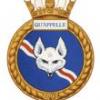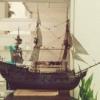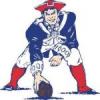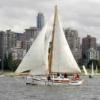-
Posts
1,501 -
Joined
-
Last visited
Reputation Activity
-
 Mahuna got a reaction from EricWilliamMarshall in Freezer Paper - an awesome tool
Mahuna got a reaction from EricWilliamMarshall in Freezer Paper - an awesome tool
Here are some photos of the Freezer Paper in use.
First, I cut out some freezer paper in 8x11.5 sheets, and flattened them by wrapping them around a piece of pvc a few times. When the curl wasn't so pronounced I loaded it into the printer and then copied part of a plan sheet (Mayflower by Chuck, purchased from Model Expo) and printed it to the freezer paper.
Then I cut out the bulkheads I was interested in, positioned them on a sheet of 1/32 plywood, and laid a medium-hot iron on top of them for about ten seconds - done. I can now cut out the bulkheads on my scroll saw. The freezer paper is adhered well enough that the saw doesn't pull it off the wood.
Hope this helps.
Frank
-
 Mahuna got a reaction from EricWilliamMarshall in Freezer Paper - an awesome tool
Mahuna got a reaction from EricWilliamMarshall in Freezer Paper - an awesome tool
I'm relatively new to ship modeling, and lately have been cutting some pieces out from patterns for spiling, etc. I started by using rubber cement to adhere the pattern to the wood, but didn't like the amount of mess and the residue left on the wood. I've tried a few other glues, but they basically gave me the same issues.
My wife is a quilter, and suggested using freezer paper (she calls it the quilter's best friend): draw the pattern on the plain side of the paper, put the waxy side down on the wood, and iron it onto the wood with a low-temperature iron. It worked great! Adheres to the wood and doesn't move around while working with it, then easily peals off with no residue on the wood. A side benefit is that the pattern can be reused if desired, since the wax on the back doesn't come off on the wood.
Since this worked, I wondered how the paper would work in a printer. I cut a piece to 8.5X11, flattened it by rolling it around a piece of pvc pipe a few times, then printed a test pattern on it in my inkjet printer (I don't think this would work in a laser printer because of the heat). It worked great. Now when I learn to use CAD and learn to loft frames using CAD, I'll be able to print out self-adhering patterns.
Frank
-
 Mahuna got a reaction from Mirabell61 in Freezer Paper - an awesome tool
Mahuna got a reaction from Mirabell61 in Freezer Paper - an awesome tool
I'm relatively new to ship modeling, and lately have been cutting some pieces out from patterns for spiling, etc. I started by using rubber cement to adhere the pattern to the wood, but didn't like the amount of mess and the residue left on the wood. I've tried a few other glues, but they basically gave me the same issues.
My wife is a quilter, and suggested using freezer paper (she calls it the quilter's best friend): draw the pattern on the plain side of the paper, put the waxy side down on the wood, and iron it onto the wood with a low-temperature iron. It worked great! Adheres to the wood and doesn't move around while working with it, then easily peals off with no residue on the wood. A side benefit is that the pattern can be reused if desired, since the wax on the back doesn't come off on the wood.
Since this worked, I wondered how the paper would work in a printer. I cut a piece to 8.5X11, flattened it by rolling it around a piece of pvc pipe a few times, then printed a test pattern on it in my inkjet printer (I don't think this would work in a laser printer because of the heat). It worked great. Now when I learn to use CAD and learn to loft frames using CAD, I'll be able to print out self-adhering patterns.
Frank
-
 Mahuna got a reaction from BassicBill in Freezer Paper - an awesome tool
Mahuna got a reaction from BassicBill in Freezer Paper - an awesome tool
I'm relatively new to ship modeling, and lately have been cutting some pieces out from patterns for spiling, etc. I started by using rubber cement to adhere the pattern to the wood, but didn't like the amount of mess and the residue left on the wood. I've tried a few other glues, but they basically gave me the same issues.
My wife is a quilter, and suggested using freezer paper (she calls it the quilter's best friend): draw the pattern on the plain side of the paper, put the waxy side down on the wood, and iron it onto the wood with a low-temperature iron. It worked great! Adheres to the wood and doesn't move around while working with it, then easily peals off with no residue on the wood. A side benefit is that the pattern can be reused if desired, since the wax on the back doesn't come off on the wood.
Since this worked, I wondered how the paper would work in a printer. I cut a piece to 8.5X11, flattened it by rolling it around a piece of pvc pipe a few times, then printed a test pattern on it in my inkjet printer (I don't think this would work in a laser printer because of the heat). It worked great. Now when I learn to use CAD and learn to loft frames using CAD, I'll be able to print out self-adhering patterns.
Frank
-
 Mahuna got a reaction from ZyXuz in Freezer Paper - an awesome tool
Mahuna got a reaction from ZyXuz in Freezer Paper - an awesome tool
I'm relatively new to ship modeling, and lately have been cutting some pieces out from patterns for spiling, etc. I started by using rubber cement to adhere the pattern to the wood, but didn't like the amount of mess and the residue left on the wood. I've tried a few other glues, but they basically gave me the same issues.
My wife is a quilter, and suggested using freezer paper (she calls it the quilter's best friend): draw the pattern on the plain side of the paper, put the waxy side down on the wood, and iron it onto the wood with a low-temperature iron. It worked great! Adheres to the wood and doesn't move around while working with it, then easily peals off with no residue on the wood. A side benefit is that the pattern can be reused if desired, since the wax on the back doesn't come off on the wood.
Since this worked, I wondered how the paper would work in a printer. I cut a piece to 8.5X11, flattened it by rolling it around a piece of pvc pipe a few times, then printed a test pattern on it in my inkjet printer (I don't think this would work in a laser printer because of the heat). It worked great. Now when I learn to use CAD and learn to loft frames using CAD, I'll be able to print out self-adhering patterns.
Frank
-
 Mahuna got a reaction from SkerryAmp in Freezer Paper - an awesome tool
Mahuna got a reaction from SkerryAmp in Freezer Paper - an awesome tool
I'm relatively new to ship modeling, and lately have been cutting some pieces out from patterns for spiling, etc. I started by using rubber cement to adhere the pattern to the wood, but didn't like the amount of mess and the residue left on the wood. I've tried a few other glues, but they basically gave me the same issues.
My wife is a quilter, and suggested using freezer paper (she calls it the quilter's best friend): draw the pattern on the plain side of the paper, put the waxy side down on the wood, and iron it onto the wood with a low-temperature iron. It worked great! Adheres to the wood and doesn't move around while working with it, then easily peals off with no residue on the wood. A side benefit is that the pattern can be reused if desired, since the wax on the back doesn't come off on the wood.
Since this worked, I wondered how the paper would work in a printer. I cut a piece to 8.5X11, flattened it by rolling it around a piece of pvc pipe a few times, then printed a test pattern on it in my inkjet printer (I don't think this would work in a laser printer because of the heat). It worked great. Now when I learn to use CAD and learn to loft frames using CAD, I'll be able to print out self-adhering patterns.
Frank
-
 Mahuna got a reaction from BareHook in Freezer Paper - an awesome tool
Mahuna got a reaction from BareHook in Freezer Paper - an awesome tool
I'm relatively new to ship modeling, and lately have been cutting some pieces out from patterns for spiling, etc. I started by using rubber cement to adhere the pattern to the wood, but didn't like the amount of mess and the residue left on the wood. I've tried a few other glues, but they basically gave me the same issues.
My wife is a quilter, and suggested using freezer paper (she calls it the quilter's best friend): draw the pattern on the plain side of the paper, put the waxy side down on the wood, and iron it onto the wood with a low-temperature iron. It worked great! Adheres to the wood and doesn't move around while working with it, then easily peals off with no residue on the wood. A side benefit is that the pattern can be reused if desired, since the wax on the back doesn't come off on the wood.
Since this worked, I wondered how the paper would work in a printer. I cut a piece to 8.5X11, flattened it by rolling it around a piece of pvc pipe a few times, then printed a test pattern on it in my inkjet printer (I don't think this would work in a laser printer because of the heat). It worked great. Now when I learn to use CAD and learn to loft frames using CAD, I'll be able to print out self-adhering patterns.
Frank
-
 Mahuna got a reaction from avsjerome2003 in Freezer Paper - an awesome tool
Mahuna got a reaction from avsjerome2003 in Freezer Paper - an awesome tool
I'm relatively new to ship modeling, and lately have been cutting some pieces out from patterns for spiling, etc. I started by using rubber cement to adhere the pattern to the wood, but didn't like the amount of mess and the residue left on the wood. I've tried a few other glues, but they basically gave me the same issues.
My wife is a quilter, and suggested using freezer paper (she calls it the quilter's best friend): draw the pattern on the plain side of the paper, put the waxy side down on the wood, and iron it onto the wood with a low-temperature iron. It worked great! Adheres to the wood and doesn't move around while working with it, then easily peals off with no residue on the wood. A side benefit is that the pattern can be reused if desired, since the wax on the back doesn't come off on the wood.
Since this worked, I wondered how the paper would work in a printer. I cut a piece to 8.5X11, flattened it by rolling it around a piece of pvc pipe a few times, then printed a test pattern on it in my inkjet printer (I don't think this would work in a laser printer because of the heat). It worked great. Now when I learn to use CAD and learn to loft frames using CAD, I'll be able to print out self-adhering patterns.
Frank
-
 Mahuna got a reaction from Mirabell61 in Freezer Paper - an awesome tool
Mahuna got a reaction from Mirabell61 in Freezer Paper - an awesome tool
Here are some photos of the Freezer Paper in use.
First, I cut out some freezer paper in 8x11.5 sheets, and flattened them by wrapping them around a piece of pvc a few times. When the curl wasn't so pronounced I loaded it into the printer and then copied part of a plan sheet (Mayflower by Chuck, purchased from Model Expo) and printed it to the freezer paper.
Then I cut out the bulkheads I was interested in, positioned them on a sheet of 1/32 plywood, and laid a medium-hot iron on top of them for about ten seconds - done. I can now cut out the bulkheads on my scroll saw. The freezer paper is adhered well enough that the saw doesn't pull it off the wood.
Hope this helps.
Frank
-
 Mahuna got a reaction from ZyXuz in Freezer Paper - an awesome tool
Mahuna got a reaction from ZyXuz in Freezer Paper - an awesome tool
Here are some photos of the Freezer Paper in use.
First, I cut out some freezer paper in 8x11.5 sheets, and flattened them by wrapping them around a piece of pvc a few times. When the curl wasn't so pronounced I loaded it into the printer and then copied part of a plan sheet (Mayflower by Chuck, purchased from Model Expo) and printed it to the freezer paper.
Then I cut out the bulkheads I was interested in, positioned them on a sheet of 1/32 plywood, and laid a medium-hot iron on top of them for about ten seconds - done. I can now cut out the bulkheads on my scroll saw. The freezer paper is adhered well enough that the saw doesn't pull it off the wood.
Hope this helps.
Frank
-
 Mahuna got a reaction from lamarvalley in Freezer Paper - an awesome tool
Mahuna got a reaction from lamarvalley in Freezer Paper - an awesome tool
I'm relatively new to ship modeling, and lately have been cutting some pieces out from patterns for spiling, etc. I started by using rubber cement to adhere the pattern to the wood, but didn't like the amount of mess and the residue left on the wood. I've tried a few other glues, but they basically gave me the same issues.
My wife is a quilter, and suggested using freezer paper (she calls it the quilter's best friend): draw the pattern on the plain side of the paper, put the waxy side down on the wood, and iron it onto the wood with a low-temperature iron. It worked great! Adheres to the wood and doesn't move around while working with it, then easily peals off with no residue on the wood. A side benefit is that the pattern can be reused if desired, since the wax on the back doesn't come off on the wood.
Since this worked, I wondered how the paper would work in a printer. I cut a piece to 8.5X11, flattened it by rolling it around a piece of pvc pipe a few times, then printed a test pattern on it in my inkjet printer (I don't think this would work in a laser printer because of the heat). It worked great. Now when I learn to use CAD and learn to loft frames using CAD, I'll be able to print out self-adhering patterns.
Frank
-
 Mahuna got a reaction from gknightiv in Freezer Paper - an awesome tool
Mahuna got a reaction from gknightiv in Freezer Paper - an awesome tool
I'm relatively new to ship modeling, and lately have been cutting some pieces out from patterns for spiling, etc. I started by using rubber cement to adhere the pattern to the wood, but didn't like the amount of mess and the residue left on the wood. I've tried a few other glues, but they basically gave me the same issues.
My wife is a quilter, and suggested using freezer paper (she calls it the quilter's best friend): draw the pattern on the plain side of the paper, put the waxy side down on the wood, and iron it onto the wood with a low-temperature iron. It worked great! Adheres to the wood and doesn't move around while working with it, then easily peals off with no residue on the wood. A side benefit is that the pattern can be reused if desired, since the wax on the back doesn't come off on the wood.
Since this worked, I wondered how the paper would work in a printer. I cut a piece to 8.5X11, flattened it by rolling it around a piece of pvc pipe a few times, then printed a test pattern on it in my inkjet printer (I don't think this would work in a laser printer because of the heat). It worked great. Now when I learn to use CAD and learn to loft frames using CAD, I'll be able to print out self-adhering patterns.
Frank
-
 Mahuna got a reaction from Nirvana in Freezer Paper - an awesome tool
Mahuna got a reaction from Nirvana in Freezer Paper - an awesome tool
I'm relatively new to ship modeling, and lately have been cutting some pieces out from patterns for spiling, etc. I started by using rubber cement to adhere the pattern to the wood, but didn't like the amount of mess and the residue left on the wood. I've tried a few other glues, but they basically gave me the same issues.
My wife is a quilter, and suggested using freezer paper (she calls it the quilter's best friend): draw the pattern on the plain side of the paper, put the waxy side down on the wood, and iron it onto the wood with a low-temperature iron. It worked great! Adheres to the wood and doesn't move around while working with it, then easily peals off with no residue on the wood. A side benefit is that the pattern can be reused if desired, since the wax on the back doesn't come off on the wood.
Since this worked, I wondered how the paper would work in a printer. I cut a piece to 8.5X11, flattened it by rolling it around a piece of pvc pipe a few times, then printed a test pattern on it in my inkjet printer (I don't think this would work in a laser printer because of the heat). It worked great. Now when I learn to use CAD and learn to loft frames using CAD, I'll be able to print out self-adhering patterns.
Frank
-
 Mahuna got a reaction from Adrieke in Freezer Paper - an awesome tool
Mahuna got a reaction from Adrieke in Freezer Paper - an awesome tool
I'm relatively new to ship modeling, and lately have been cutting some pieces out from patterns for spiling, etc. I started by using rubber cement to adhere the pattern to the wood, but didn't like the amount of mess and the residue left on the wood. I've tried a few other glues, but they basically gave me the same issues.
My wife is a quilter, and suggested using freezer paper (she calls it the quilter's best friend): draw the pattern on the plain side of the paper, put the waxy side down on the wood, and iron it onto the wood with a low-temperature iron. It worked great! Adheres to the wood and doesn't move around while working with it, then easily peals off with no residue on the wood. A side benefit is that the pattern can be reused if desired, since the wax on the back doesn't come off on the wood.
Since this worked, I wondered how the paper would work in a printer. I cut a piece to 8.5X11, flattened it by rolling it around a piece of pvc pipe a few times, then printed a test pattern on it in my inkjet printer (I don't think this would work in a laser printer because of the heat). It worked great. Now when I learn to use CAD and learn to loft frames using CAD, I'll be able to print out self-adhering patterns.
Frank
-
 Mahuna got a reaction from RiverRat in Freezer Paper - an awesome tool
Mahuna got a reaction from RiverRat in Freezer Paper - an awesome tool
I'm relatively new to ship modeling, and lately have been cutting some pieces out from patterns for spiling, etc. I started by using rubber cement to adhere the pattern to the wood, but didn't like the amount of mess and the residue left on the wood. I've tried a few other glues, but they basically gave me the same issues.
My wife is a quilter, and suggested using freezer paper (she calls it the quilter's best friend): draw the pattern on the plain side of the paper, put the waxy side down on the wood, and iron it onto the wood with a low-temperature iron. It worked great! Adheres to the wood and doesn't move around while working with it, then easily peals off with no residue on the wood. A side benefit is that the pattern can be reused if desired, since the wax on the back doesn't come off on the wood.
Since this worked, I wondered how the paper would work in a printer. I cut a piece to 8.5X11, flattened it by rolling it around a piece of pvc pipe a few times, then printed a test pattern on it in my inkjet printer (I don't think this would work in a laser printer because of the heat). It worked great. Now when I learn to use CAD and learn to loft frames using CAD, I'll be able to print out self-adhering patterns.
Frank
-
 Mahuna got a reaction from tarbrush in Freezer Paper - an awesome tool
Mahuna got a reaction from tarbrush in Freezer Paper - an awesome tool
I'm relatively new to ship modeling, and lately have been cutting some pieces out from patterns for spiling, etc. I started by using rubber cement to adhere the pattern to the wood, but didn't like the amount of mess and the residue left on the wood. I've tried a few other glues, but they basically gave me the same issues.
My wife is a quilter, and suggested using freezer paper (she calls it the quilter's best friend): draw the pattern on the plain side of the paper, put the waxy side down on the wood, and iron it onto the wood with a low-temperature iron. It worked great! Adheres to the wood and doesn't move around while working with it, then easily peals off with no residue on the wood. A side benefit is that the pattern can be reused if desired, since the wax on the back doesn't come off on the wood.
Since this worked, I wondered how the paper would work in a printer. I cut a piece to 8.5X11, flattened it by rolling it around a piece of pvc pipe a few times, then printed a test pattern on it in my inkjet printer (I don't think this would work in a laser printer because of the heat). It worked great. Now when I learn to use CAD and learn to loft frames using CAD, I'll be able to print out self-adhering patterns.
Frank
-
 Mahuna got a reaction from JPett in Priming Dowel?
Mahuna got a reaction from JPett in Priming Dowel?
Water based paint will raise the grain of the wood (one reason why Russ is sanding after each of the first couple of coats). The wood can be sealed with a light coat of a mixture of 1 part clear lacquer to 1 part lacquer thinner. That's the primer used by bird carvers before painting birds carved from tupelo or basswood with acrylic washes. No sanding should be needed after painting if the wood is primed with this mixture. It's important that after this priming the wood should not be handled, since the oil from your hand will keep the acrylic from adhering properly.
Hope this helps,
Frank
-
 Mahuna reacted to Salty Sea Dog in Muscongus Bay Lobster Smack by Dee_Dee - FINISHED - Midwest Products – 1:24 – Kit Bashed - Small
Mahuna reacted to Salty Sea Dog in Muscongus Bay Lobster Smack by Dee_Dee - FINISHED - Midwest Products – 1:24 – Kit Bashed - Small
Hi Dee Dee!
I'm sure glad you are paving the way with all the details you're working out. Really nice work!
Thanks for the nice words about my whaleboat. Hope you enjoy your trip to Colorado Springs.
P.S. After reading your comment I realized I had made a typo, the Martin was a 1927 OO-18 instead of a D-18. A really sweet tone. It was tough to return that one to its owner after the repair!
-
 Mahuna reacted to captainbob in Grand Banks dory by Cap'n'Bob - FINISHED - 1:32 - SMALL
Mahuna reacted to captainbob in Grand Banks dory by Cap'n'Bob - FINISHED - 1:32 - SMALL
Thanks to everyone who has been watching this build. I sorry it’s been so long since the last entry. I’m going to call this one done for now. I hope to do something else and use this dory then but for now this is it.
The gear shown is: a Line bucket, a bait bucket, a lunch bucket, oars, a club, a bailing scoop, a cutting board and knife, on the thwart and a coil of rope. There is a divider about in the middle of the boat. The fisherman is in the bow with all the gear and he loads the fish into the other end. You will notice there is no sail. Use of a sail was up to the fisherman. The way I heard it stated is. The schooner is the dormitory and kitchen but the dory is the fisherman’s home, (he in it about 12 hours a day) and he modifies it to his liking.
Here are the pictures for now.
The admiral saw a picture of a sweet little gaff rigged yawl and said “That would be a nice model”, and what the admiral wants. . .
Bob
-
 Mahuna got a reaction from trippwj in Introductory Texts on Wooden Ship Building
Mahuna got a reaction from trippwj in Introductory Texts on Wooden Ship Building
Thanks Wayne - this list will be very useful.
Frank
-
 Mahuna got a reaction from WackoWolf in Air brushing
Mahuna got a reaction from WackoWolf in Air brushing
I would suggest a double-action for control.
Gravity feed, for several reasons: 1) needs less air pressure, 2) generally holds less paint, so less waste, 3) easier clean-up.
Internal Mix is easier to learn and use.
Compressor needs to output at least 30 psi.
A friend purchased a compressor/airbrush combo from Model Expo that was well within your price and was an excellent value. You won't need a higher-level airbrush (Badger, Iwata) to start out. ME has a sale on right now (code MAD13), and is offering a nice compressor/airbrush combo for $115.
http://www.modelexpo-online.com/product.asp?ITEMNO=AS176K
Here's a link to a site that gives good airbrush lessons:
http://howtoairbrush.com/airbrush-lessons/
Frank
-
 Mahuna got a reaction from BOYSEE in Jim Byrnes Model Machines
Mahuna got a reaction from BOYSEE in Jim Byrnes Model Machines
Just wanted to make a comment on the service I've received from Jim Byrnes:
A few months ago I purchased Jim's table saw - I see why this is the most sought-after saw for modelers. Being new to the use of table saws in general, I've been proceeding slowly. I've been using the standard blade, and wanted to start using a slitting blade, but wasn't sure how to cut a zero-tolerance insert for the blade. I also had a few questions on the process for cutting very thin planks (1/32).
I sent Jim an email via the Model Machines website, and received a personal email from Jim within a couple of hours. Jim answered all of my questions and was very supportive. Contrast this to some other sites where it took days for any answer, if one was received at all.
Jim's quality machines and workmanship are matched by his commitment to customer service, and he's a pleasure to deal with.
Thank you Jim!!
Frank
-
 Mahuna got a reaction from lb0190 in Jim Byrnes Model Machines
Mahuna got a reaction from lb0190 in Jim Byrnes Model Machines
Just wanted to make a comment on the service I've received from Jim Byrnes:
A few months ago I purchased Jim's table saw - I see why this is the most sought-after saw for modelers. Being new to the use of table saws in general, I've been proceeding slowly. I've been using the standard blade, and wanted to start using a slitting blade, but wasn't sure how to cut a zero-tolerance insert for the blade. I also had a few questions on the process for cutting very thin planks (1/32).
I sent Jim an email via the Model Machines website, and received a personal email from Jim within a couple of hours. Jim answered all of my questions and was very supportive. Contrast this to some other sites where it took days for any answer, if one was received at all.
Jim's quality machines and workmanship are matched by his commitment to customer service, and he's a pleasure to deal with.
Thank you Jim!!
Frank
-
 Mahuna got a reaction from Don Stansky in Jim Byrnes Model Machines
Mahuna got a reaction from Don Stansky in Jim Byrnes Model Machines
Just wanted to make a comment on the service I've received from Jim Byrnes:
A few months ago I purchased Jim's table saw - I see why this is the most sought-after saw for modelers. Being new to the use of table saws in general, I've been proceeding slowly. I've been using the standard blade, and wanted to start using a slitting blade, but wasn't sure how to cut a zero-tolerance insert for the blade. I also had a few questions on the process for cutting very thin planks (1/32).
I sent Jim an email via the Model Machines website, and received a personal email from Jim within a couple of hours. Jim answered all of my questions and was very supportive. Contrast this to some other sites where it took days for any answer, if one was received at all.
Jim's quality machines and workmanship are matched by his commitment to customer service, and he's a pleasure to deal with.
Thank you Jim!!
Frank
-
 Mahuna got a reaction from SkerryAmp in Jim Byrnes Model Machines
Mahuna got a reaction from SkerryAmp in Jim Byrnes Model Machines
Just wanted to make a comment on the service I've received from Jim Byrnes:
A few months ago I purchased Jim's table saw - I see why this is the most sought-after saw for modelers. Being new to the use of table saws in general, I've been proceeding slowly. I've been using the standard blade, and wanted to start using a slitting blade, but wasn't sure how to cut a zero-tolerance insert for the blade. I also had a few questions on the process for cutting very thin planks (1/32).
I sent Jim an email via the Model Machines website, and received a personal email from Jim within a couple of hours. Jim answered all of my questions and was very supportive. Contrast this to some other sites where it took days for any answer, if one was received at all.
Jim's quality machines and workmanship are matched by his commitment to customer service, and he's a pleasure to deal with.
Thank you Jim!!
Frank



.thumb.jpeg.fc5d633a7b34428fcf19419a73d56d55.jpeg)













